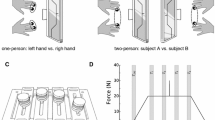Abstract
We have investigated how the control of hand transport and of hand aperture are coordinated in prehensile movements by delivering mechanical perturbations to the hand transport component and looking for coordinated adjustments in hand aperture. An electric actuator attached to the subject's right arm randomly pulled the subject backwards, away from the target, or pushed them towards it, during a quarter of the experimental trials. A compensatory adjustment of hand aperture followed the immediate, mechanical effects of the perturbation of hand transport. The adjustment appeared to return the subject towards a stereotyped spatial relation between hand aperture and hand transport. These spatial patterns suggest how the two components may be coordinated during prehension. A simple model of this coordination, based on coupled position feedback systems, is presented.
Similar content being viewed by others
References
Bennett DJ, Hollerbach JM, Xu Y, Hunter IW (1992) Time-varying stiffness of human elbow-joint during cyclic voluntary movement. Exp Brain Res 88: 433–442
Bizzi E, Accornero N, Chapple W, Hogan N (1984) Posture control and trajectory formation during arm movement. J Neurosci4: 2738–2744
Bullock D, Grossberg S (1988) Neural dynamics of planned arm movements: emergent invariants and speed-accuracy properties during trajectory formation. Psychol Rev 95: 49–90
Crossman ERFW, Goodeve TJ (1983) Feedback control of hand movement and Fills' Law. Q J Exp Psychol 35A: 251–278
Cutkosky MR (1985) Robotic grasping and fine manipulation. Kluwer Academic, Boston
Fel'dman AG (1966a) Functional tuning of the nervous system with control of movement or maintenance of a steady posture. II. Controllable parameters of the muscles. Biophysics 11: 565–578
Fel'dman AG (1966b) Functional tuning of the nervous system with control of movement or maintenance of a steady posture. III. Mechanographic analysis of the execution by man of the simplest motor tasks. Biophysics 11: 667–675
Flash T (1987) The control of hand equilibrium trajectories in multi-joint arm movements. Biol Cybern 57: 257–274
Gentilucci M, Castiello U, Corradii ML, Scarpa M, Umiltà C, Rizzolatti G (1991) Neuropsychologia 29: 361–378
Haggard P (1994) Perturbation studies of human prehension. In: Bennett KMB, Castiello U (eds) New insights into the reach to grasp movement. North-Holland, Amsterdam, pp 151–170
Haggard P, Wing AM (1990) Assessing and reporting the accuracy of position measurements made with optical tracking devices. J Mot Behav 22: 315–321
Haggard P, Wing AM (1991) Remote responses to perturbation in human prehension. Neurosci Lett 122: 103–108
Hoff B, Arbib MA (1993) Models of Trajectory Formation and Temporal Interaction of Reach and Grasp. J Mot Behav 25: 175–192
Hogan N (1984) An organizing principle for a class of voluntary movements. J Neurosci 4: 2745–2754
Jakobson LS, Archibald YM, Carey DP, Goodale MA (1991) A kinematic analysis of reaching and grasping movements in a patient recovering from optic ataxia. Neuropsychologia 29: 803–810
Jeannerod M (1981) Intersegmental coordination during reaching at natural objects. In: Long J, Baddeley AD (eds) Attention and performance, IX. Erlbaum, Hillsdale, N. J. pp 153–169
Jeannerod M (1984) The timing of natural prehension movement. J Mot Behav 26: 235–254
Morasso P (1981) Spatial control of arm movements. Exp Brain Res 42: 223–227
Paulignan Y, MacKenzie C, Marteniuk R, Jeannerod M (1991a) Selective perturbation of visual input during prehension movements. 1. The effects of changing object position. Exp Brain Res 83: 502–512
Paulignan Y, Jeannerod M, MacKenzie C, Marteniuk R (1991b) Selective perturbation of visual input during prehension movements. 2. The effects of changing object size. Exp Brain Res87: 407–420
Polit A, Bizzi E (1979) Characteristics of the motor programs underlying arm movements in monkeys. J Neurophysiol 42: 183–194
Rodgers CT, Goodall RN, Pratt DJ (1986) Control and instrumentation systems in the enhancement of postural stability. Progress Reports on Electronics in Medicine and Biology for 1986. Institute of Electronic and Radio Engineers, pp 131–38
Saltzman E, Kelso JAS (1987) Skilled actions: a task-dynamic approach. Psychol Rev 94: 84–106
Wing AM, Turton A, Fraser C (1986) Grasp size and accuracy of approach in reaching. J Mot Behav 18: 245–260
Author information
Authors and Affiliations
Rights and permissions
About this article
Cite this article
Haggard, P., Wing, A. Coordinated responses following mechanical perturbation of the arm during prehension. Exp Brain Res 102, 483–494 (1995). https://doi.org/10.1007/BF00230652
Received:
Accepted:
Issue Date:
DOI: https://doi.org/10.1007/BF00230652




